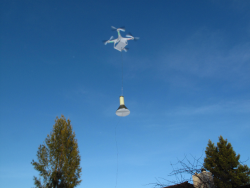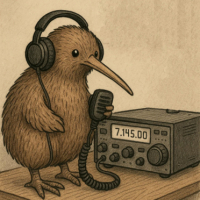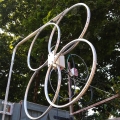n6gn
About
- Username
- n6gn
- Joined
- Visits
- 5,482
- Last Active
- Roles
- Member
- Points
- 31
-
MIni Enhancement on the new S meter
-
DIY MW Bandstop Filter PCB
I tried to attach a file to this posting, daughter1.2.brd, which if dropped onto OSHPark's PCB fabrication site and submitted should result in a small PCB that can be loaded with SMD parts to produce a MW bandstop filter for use with the KiwiSDR or other SDRs that might suffer from overload in the .6-1.6 MHz region. The forum wouldn't let me post a file of this type so after I send this I'll try to post it to a files section, if I can. If not, ask and I can email it to you directly.
As shown, this filter suppresses signals in this range 15-20 dB without significantly affecting the rest of signals within the SDR's range.The board can be fabricated at nominal cost, OSHPark provided me with 3 boards shipped postpaid (they advertize free shipping worldwide) for under US$4. To build it you'll need to obtain the L's, C's and R's and solder them and two coax connectors onto the PCB but parts are not special and can be ordered from Mouser, Digikey or your favorite supplier. I would suggest selecting 5% tolerance if possible but use what you can get. R's and C's are 0603 package and the L's are 1210. The inductors are standard values which should be commonly available and the nearest available capacitor values should be fine. If necessary you may parallel two capacitors to get near the value indicated on the schematic. If you can get within 5-10 % the filter should work approximately as shown. Don't worry about being too precise, the resonances are mostly lower Q and thus not terribly critical. Here's what it looks like after less than an hour's effort:

Either SMA or SMB connectors may be used and edge-mounted. These are no doubt the most expensive part of the filter so if you really want to be frugal you can simply solder coax directly to the board instead.
Even without careful parts value selection here's a good approximation of what you should end up with
You'll see that there is left unloaded one series RLC trap. I included this because I have a significant problem with an LF signal, WWVB at 60 kHz, overloading my KiwiSDR which the MW bandstop didn't address. The situation at your location will no doubt be different but you can easily add two or three parts and greatly reduce a single frequency if you do have a problem from a strong local like I did.
This is by no means the only selection of values that can work. You can use an Open Source circuit simulator such as QUCS to obtain different values from what I chose if you'd like different performance. My goal was to get a enough attenuation to keep the KiwiSDR out of overload and with fairly flat stop band so that it would be easy to arrive at a reasonable estimate of unfiltered signal strength by just adding a constant back in for any signal in the MW stop band. If your problem is other than MW, perhaps strong SW broadcast overload from one of the HF bands, you can generate new values but use the same board to make a different filter.
If I don't succeed in getting the .brd file posted, write me and I'll be happy to mail it to you. Similarly if you have questions ask and I'll do my best to answer them.
Glenn n6gn
Fort Collins, Colorado -
DIY MW Bandstop Filter PCB
I tried to attach a file to this posting, daughter1.2.brd, which if dropped onto OSHPark's PCB fabrication site and submitted should result in a small PCB that can be loaded with SMD parts to produce a MW bandstop filter for use with the KiwiSDR or other SDRs that might suffer from overload in the .6-1.6 MHz region. The forum wouldn't let me post a file of this type so after I send this I'll try to post it to a files section, if I can. If not, ask and I can email it to you directly.
As shown, this filter suppresses signals in this range 15-20 dB without significantly affecting the rest of signals within the SDR's range.The board can be fabricated at nominal cost, OSHPark provided me with 3 boards shipped postpaid (they advertize free shipping worldwide) for under US$4. To build it you'll need to obtain the L's, C's and R's and solder them and two coax connectors onto the PCB but parts are not special and can be ordered from Mouser, Digikey or your favorite supplier. I would suggest selecting 5% tolerance if possible but use what you can get. R's and C's are 0603 package and the L's are 1210. The inductors are standard values which should be commonly available and the nearest available capacitor values should be fine. If necessary you may parallel two capacitors to get near the value indicated on the schematic. If you can get within 5-10 % the filter should work approximately as shown. Don't worry about being too precise, the resonances are mostly lower Q and thus not terribly critical. Here's what it looks like after less than an hour's effort:

Either SMA or SMB connectors may be used and edge-mounted. These are no doubt the most expensive part of the filter so if you really want to be frugal you can simply solder coax directly to the board instead.
Even without careful parts value selection here's a good approximation of what you should end up with
You'll see that there is left unloaded one series RLC trap. I included this because I have a significant problem with an LF signal, WWVB at 60 kHz, overloading my KiwiSDR which the MW bandstop didn't address. The situation at your location will no doubt be different but you can easily add two or three parts and greatly reduce a single frequency if you do have a problem from a strong local like I did.
This is by no means the only selection of values that can work. You can use an Open Source circuit simulator such as QUCS to obtain different values from what I chose if you'd like different performance. My goal was to get a enough attenuation to keep the KiwiSDR out of overload and with fairly flat stop band so that it would be easy to arrive at a reasonable estimate of unfiltered signal strength by just adding a constant back in for any signal in the MW stop band. If your problem is other than MW, perhaps strong SW broadcast overload from one of the HF bands, you can generate new values but use the same board to make a different filter.
If I don't succeed in getting the .brd file posted, write me and I'll be happy to mail it to you. Similarly if you have questions ask and I'll do my best to answer them.
Glenn n6gn
Fort Collins, Colorado -
An antenna switch for the KiwiSDR
-
Washed out signal help






